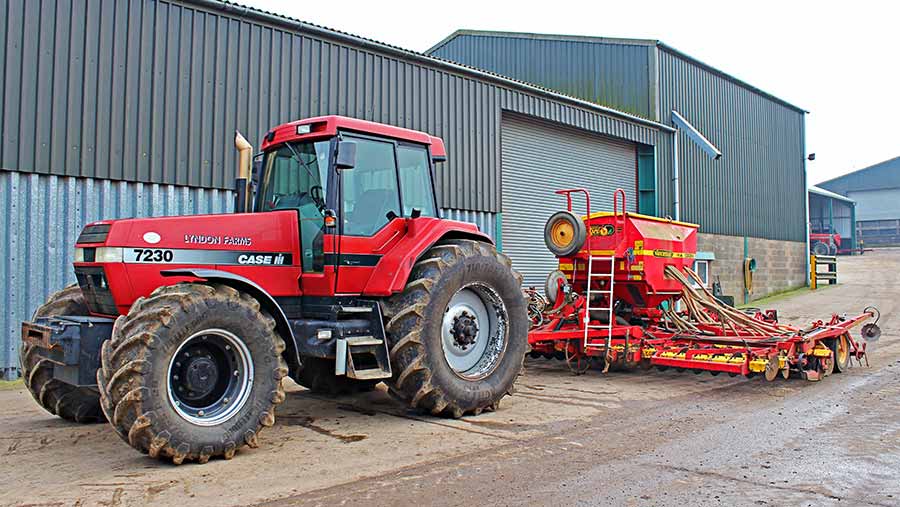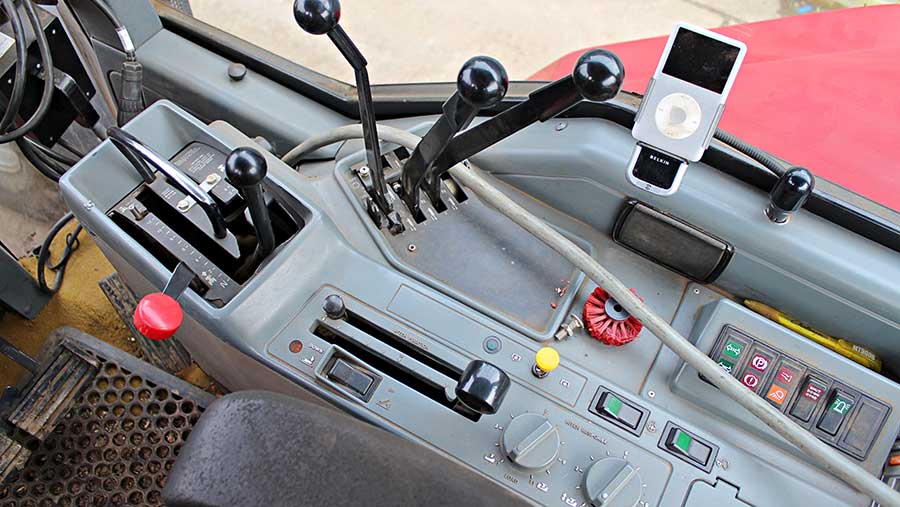Driver’s view: 1997 Case-IH Magnum 7230 still paying its way
 © James Andrews
© James Andrews After a series of pricey breakdowns with newer tractors, Leicestershire contractors Leon and Simon Smith decided to try some older, simpler horsepower.
The pair’s mechanical woes came to a head back in 2006 when they bought a particularly troublesome McCormick XTX215. The tractor arrived in January, fresh off the production line, but immediately started playing up.
Their local dealer, AT Houghton, stood by it and kept it running, but come October it had packed in yet again and they were without a tractor capable of pulling their JF FCT 1350 forager.
See also: Driver’s view: Valtra’s 170hp T163e tractor
As luck would have it, AT Houghton had recently taken in a tidy 1997 Magnum 7230 that, with 215hp on tap, looked to be just about up to the job. They bought it with 3,500 hours on the clock and put it straight to work.
Ten years on, it is still one of the farm’s frontline tractors and has just nudged past 6,700 hours. Farmers Weekly finds out how it has performed during its 10 years in office.

Leon Smith © James Andrews
Why is the 7230 still on the fleet?
There are plenty of reasons, but the main ones are that it’s simple, reliable, pulls well and is surprisingly comfortable to drive.
Depreciation is also virtually nil. We bought it for £23,000, we’ve put 3,200 hours on the clock and I’m sure we could get £19,000 for it now. There’s no way a new tractor could offer you that low a cost of ownership.
We’ve also had some other pretty disappointing experiences with new tractors. Just after the 7230 arrived we bought a Magnum 310 that could barely do a day’s work without something going wrong.
It was horrendous – the clutch packs went, the front diff packed in, the hydraulics were never working properly and the steering valve had to be replaced, all in a very short space of time.
With older tractors you never used to worry that you only had a 12-month warranty. But new ones are so complicated and potentially troublesome that you’re taking a real gamble if you run one outside the warranty deal.
Lyndon Farms’ Case-IH Magnum 7230
- Year: 1997
- Purchased in: 2006
- Purchase price: £23,000
- Engine hours at purchase: 3,500
- Engine hours now: 6,700
- Engine: 8.3-litre, six-cylinder Cummins
- Transmission: 18-speed powershift with 4 reverse
- Weight: About 8t
- Tyres: 710/70 R38 rear and 600/65 R28 front
How much power has it got?
When we hooked it to a dyno, it was putting out 215hp. It certainly isn’t the most powerful tractor we’ve got, but it’s got so much torque that it’s near impossible to stall it.
That meant it was super smooth and gentle when we had it on the forager.
If you hit a lump it would just drag the engine down and as the load lightened it would pick straight back up.
We considered turning the pump up to give it a bit more go.
However, almost every tractor we’ve had that someone’s tampered with or chipped has been a disappointment, so we decided to leave it alone.
Surprisingly, it goes a lot better than the 7250 we bought in 2010 to run alongside it, even though that’s meant to have 50hp more.
Both have the same engine and running gear, but the 7250 has an intercooler and seems to be set up a bit differently.
Whatever those differences are, it means it doesn’t have as much torque as the 7230 at the bottom end.

© James Andrews
What do you pull with it?
The 7230 spends most of its time hooked to a 6m Vaderstad Rapid, which it manages to pull just fine.
We tend to drill at a steady 10kph and will comfortably cover 45ha in a day.
It doesn’t fly up the banks, but you just have to accept the fact you need to drop a couple of gears.
Likes
- Impressive torque
- Surprisingly comfortable to drive in the field
- Simple and reliable
Gripes
- Heavy for a 215hp tractor
- Uncomfortable on the road
- Wheel studs work loose
In total, it drills around 500ha of cereals a season with the Rapid, plus some oilseed rape sowing with the farm’s 4.6m Claydon V Drill. It also does the odd stint with a 3.2m Cousins V Form.
This season we’ve stopped tramlining with the Rapid and are relying on the sprayer to put the wheel marks in with GPS.
We’ve steered clear of using GPS on the drill, but we’ve set the markers so that we run at a full 6m and we’ve added an extra coulter on each side to make sure we don’t get any misses.
What’s it like on the road?
In the field it’s a really relaxing tractor to drive, but when you take it on the road it’s sluggish, bounces around, is noisy and generally pretty unpleasant.
The powershift transmission also isn’t suited to road work, particularly when you get to a junction and have to notch back through all the gears.
But that’s why we’ve got the Fastracs. Any tractor that tries to do everything is a compromise so we prefer to have a larger number of second-hand machines that are perfectly suited to one or two tasks.
We’ve also got the Cat 755B crawler, which is almost permanently hooked to our KV Stubble Finisher.
Has it been reliable?
Thankfully it’s got very few vices, but we have had to do a few things to it over the years.
The biggest outlay was for a new pto pack that cost £1,500. We think this was damaged when the pto on the forager snapped and jammed against the drawbar, stopping the tractor dead.
The exhaust also rotted through, so we got a local fabricator to make us a straight-through stainless steel version, which gives it a real bark. That set us back about £250 and we spent another £200 on a kit to rebuild the power steering ram.
Other than that, it’s just had the odd hydraulic hose and light bulb.
Lyndon Farms’ tractor fleet
- Challenger MT755B
- Case-IH Magnum 7230 and 7250
- Case-IH Puma 230
- Case-IH MX170
- Case-IH MX135 x 2
- Case-IH MX110
- McCormick MTX150
- JCB Fastrac 2155 and 2170 x 2
- Claas Arion 630
- International 955XL, 1255 and 1455
- Massey Ferguson 2645
Any modifications?
We had a bit of trouble with the wheel studs working loose. In the US, most 7230s came with cast centres and for some reason the wheel studs won’t grip on the steel rims fitted on our tractor.
As a test we’ve converted one side to lorry studs, which seem to be doing the trick, so the other side is one the to-do list.
We also pushed the front weight frame further forward as the 600mm tyres would hit the weights before the steering got to full lock.
The next job is to redo the door hinges, which have worn and sagged over the years meaning the door doesn’t shut properly. The gas strut could do with replacing, too.
As an aside, we recently treated it to a new set of BKT 710/70 R38 tyres on the rear. They were about half the price of the Michelins they replaced and they’ve been performing just as well.
Are you running any other older tractors?
Most of our tractors are getting on a bit and have got plenty of hours on the clock.
Our everyday run-arounds are two Case MX135s that have each got about 13,000 hours on the clock and have given us very little trouble. We’ve also got an MX110 and MX170, which all hail from the late 1990s/early 2000s.
For haulage work we’ve got three 2000-series JCB Fastracs and for heavy tillage work we’ve got the Challenger MT755B.
The only newish tractor on the fleet is a Case-IH Puma 230 that spends most of its time forage clamping and ploughing.
Are you still using interesting older machinery?
It’s all too easy to focus on the newest tractors and farm machinery. But at Farmers Weekly we’re always interested to hear from people who are clocking up long, hard hours on older, quirkier kit.
So if you’re still regularly using a machine that’s a bit different or particularly long in the tooth, please get in touch by emailing oliver.mark@rbi.co.uk.

